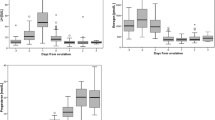Abstract
CESSATION of cyclic ovarian activity in ewes during anœstrus is thought to be associated with changes in the level and/or type of gonadotrophic substances reaching the ovary1. This supposition cannot be tested by direct means at the present time, but a recently developed technique for synchronization of ovulation in ewes2 suggests possibilities of an indirect examination.
This is a preview of subscription content, access via your institution
Access options
Subscribe to this journal
Receive 51 print issues and online access
$199.00 per year
only $3.90 per issue
Buy this article
- Purchase on SpringerLink
- Instant access to full article PDF
Prices may be subject to local taxes which are calculated during checkout
Similar content being viewed by others
References
Robinson, T. J., Biol. Rev., 26, 121 (1951).
Braden, A. W. H., Lamond, D. R., and Radford, H. M., Aust. J. Agric. Res., 11, 389 (1960).
Evans, H. M., and Simpson, M. E., “The Hormones”, 2, edit. by Pincus, G., and Thimann, K. V. (Academic Press, New York, 1950).
Lamond, D. R., J. Endocrinol. (in the press).
Author information
Authors and Affiliations
Rights and permissions
About this article
Cite this article
LAMOND, D. Seasonal Differences in Ovulating Hormone in the Merino Ewe. Nature 186, 971–972 (1960). https://doi.org/10.1038/186971b0
Issue date:
DOI: https://doi.org/10.1038/186971b0



